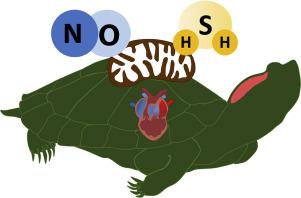Comparative Biochemistry and Physiology A: Molecular & Integrative Physiology ( IF 2.3 ) Pub Date : 2020-12-01 , DOI: 10.1016/j.cbpa.2020.110857 Amanda Bundgaard 1 , Birgitte S Jensen 1 , Frank B Jensen 2 , Angela Fago 1

|
In contrast to most vertebrates, freshwater turtles of the genera Trachemys and Chrysemys survive total oxygen deprivation for long periods of time. This remarkable tolerance makes them ideal August Krogh's model animals to study adaptions to survive oxygen deprivation. The gasotransmitters nitric oxide (NO) and hydrogen sulfide (H2S) and their metabolic derivatives are central in regulating the physiological responses to oxygen deprivation. Here, we explore the role of these signaling molecules in the anoxia tolerance of the freshwater turtle, including metabolic suppression and protection against oxidative damage with oxygen deprivation. We describe the interaction of NO and H2S with protein thiols and specifically how this regulates the function of central metabolic enzymes. These interactions contribute both to metabolic suppression and to prevent oxidative damage with oxygen deprivation. Furthermore, NO and H2S interact with ferrous and ferric heme iron, respectively, which affects the activity of central heme proteins. In turtles, these interactions contribute to regulate oxygen consumption in the mitochondria, as well as vascular tone and blood flow during oxygen deprivation. The versatile biological effects of NO and H2S underscore the importance of these volatile signaling molecules in the remarkable tolerance of freshwater turtles to oxygen deprivation.
中文翻译:

探索代谢抑制中 NO 和 H2S 信号通路:以缺氧龟为例
与大多数脊椎动物相比,Trachemys和Chrysemys属的淡水龟可以长时间完全缺氧。这种非凡的耐受性使它们成为奥古斯特·克罗 (August Krogh) 研究在缺氧条件下生存的理想模型动物。气体递质一氧化氮 (NO) 和硫化氢 (H 2 S) 及其代谢衍生物在调节对缺氧的生理反应中起着核心作用。在这里,我们探索了这些信号分子在淡水龟的缺氧耐受性中的作用,包括代谢抑制和防止缺氧引起的氧化损伤。我们描述了 NO 和 H 2的相互作用S 与蛋白质硫醇,特别是它如何调节中枢代谢酶的功能。这些相互作用有助于抑制代谢和防止缺氧引起的氧化损伤。此外,NO 和 H 2 S 分别与亚铁和三价血红素铁相互作用,从而影响中枢血红素蛋白的活性。在海龟中,这些相互作用有助于调节线粒体中的耗氧量,以及缺氧期间的血管张力和血流。NO 和 H 2 S的多功能生物效应强调了这些挥发性信号分子在淡水龟对缺氧的显着耐受性中的重要性。



























 京公网安备 11010802027423号
京公网安备 11010802027423号